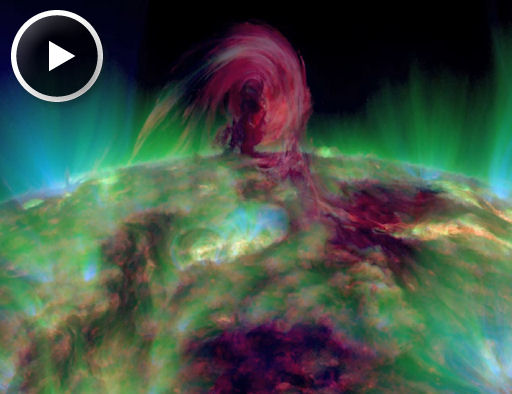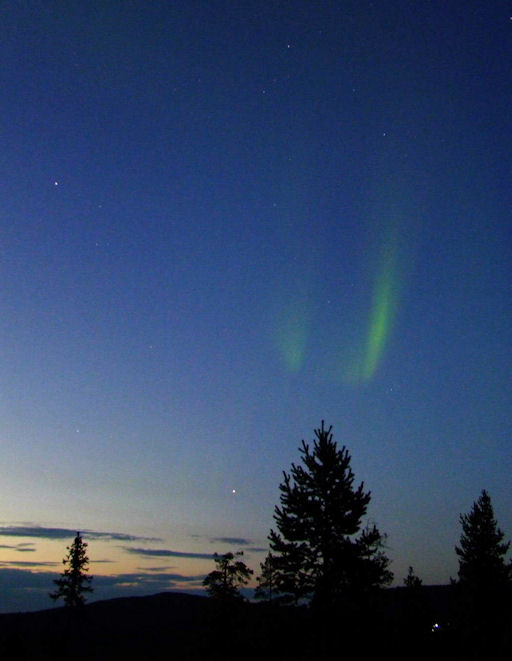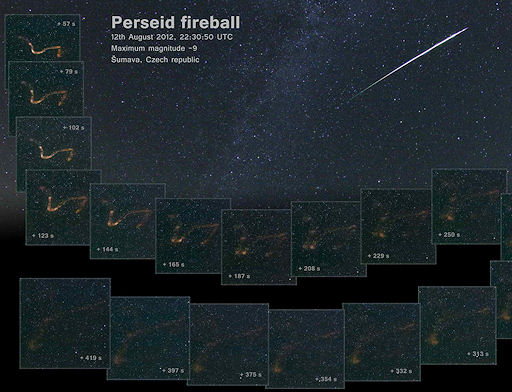SIGNIFICANT SOLAR FLARE, NOT EARTH-DIRECTED: Magnetic fields snaking over the sun's northeastern limb erupted on August 18th around 01:02 UT. The M5.5 class eruption was not Earth-directed, but it could herald a significant uptick in geoeffective solar activity as the new active region turns toward Earth in the days ahead. Solar flare alerts: text, phone.
NASA's Solar Dynamic Observatory recorded the eruption:
Stay tuned for updates on this event.
RETURN OF THE ARCTIC AURORAS: It has been a while since sky watchers around the Arctic Circle have enjoyed the Northern Lights. Auroras are hard to see through the glare of the midnight sun. As summer comes to an end, however, aurora season is beginning again. Last night, B.Art Braafhart spotted a splash of green over Salla in the Finnish Lapland:
"Finally, after three nights hunting for 'the green lights,' I made the first catch of the new season," says Braafhart. "The nice temperature (+12C) was accompanied by zooming mosquitos around midnight. The apparition was brief, the colors thin and light, but after an absence of 4 months exciting again!"
More auroras could be in the offing tonight. NOAA forecasters estimate a 15% to 20% chance of polar geomagnetic storms on August 17th in response to the possible impact of a minor CME. Aurora alerts: text, phone.
Realtime Space Weather Photo Gallery
METEOR SMOKE: Researchers using NASA's AIM spacecraft have recently discovered that meteor smoke is a key ingredient of Earth's mysterious noctilucent clouds. "Meteor smoke" is the fine ashen debris left over when a meteoroid burns up in the atmosphere. On August 12th, during the peak of the Perseid meteor shower, Petr Horálek photographed a dense plume of the material twisting and turning over Sumava, Czech republic:
"The fireball that produced this smoke was magnitude -9, [almost as bright as a quarter moon]," says Horálek. "This could be the brightest fireball of the 2012 Perseids." The smokey trail was visible for more than five minutes before it finally dispersed.
If the AIM science team is correct, this smoke will drift through the upper reaches of Earth's atmosphere more than 80 km above the planet's surface. Up there, rare molecules of water will cling to the meteoritic particles, slowly gathering to form tiny crystals of ice until--voilà! A noctilucent cloud is born.
For more whiffs of meteor smoke, click on the link below:

![]()
Solar wind
speed: 381.0 km/sec
density: 2.0 protons/cm3
explanation | more data
Updated: Today at 1456 UT
![]()
X-ray Solar Flares
6-hr max: C2 0837 UT Aug18
24-hr: M5 0102 UT Aug18
explanation | more data
Updated: Today at: 1400 UT
![]()
![]()
![]()
Daily Sun: 17 Aug 12
![]()
![]()
Sunspot 1543 poses a slight threat for M-class solar flares. Credit: SDO/HMI
![]()
![]()
![]()
Sunspot number: 42
What is the sunspot number?
Updated 17 Aug 2012
Spotless Days
Current Stretch: 0 days
2012 total: 0 days (0%)
2011 total: 2 days (<1%)
2010 total: 51 days (14%)
2009 total: 260 days (71%)
Since 2004: 821 days
Typical Solar Min: 486 days
Update 17 Aug 2012
The Radio Sun
10.7 cm flux: 98 sfu
explanation | more data
Updated 17 Aug 2012
![]()
![]()
![]()
Current Auroral Oval:
![]()
Switch to: Europe, USA, New Zealand, Antarctica
Credit: NOAA/POES
![]()
![]()
![]()
Planetary K-index
Now: Kp= 2 quiet
24-hr max: Kp= 2 quiet
explanation | more data
![]()
Interplanetary Mag. Field
Btotal: 7.1 nT
Bz: 2.0 nT north
explanation | more data
Updated: Today at 1456 UT
![]()
![]()
![]()
Coronal Holes: 17 Aug 12
![]()
![]()
A solar wind stream flowing from the indicated coronal hole should reach Earth on ~Aug. 20. Credit: SDO/AIA.







